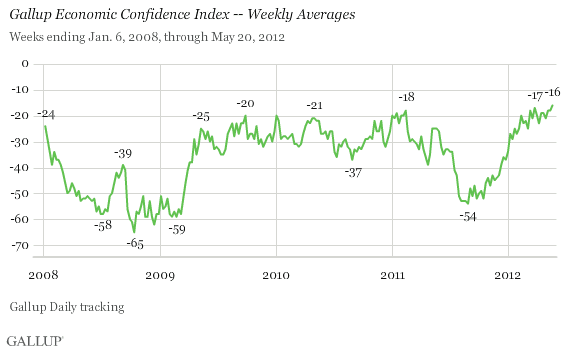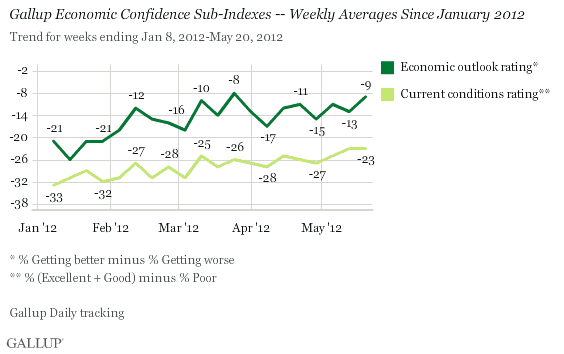PRINCETON, NJ -- The Gallup Economic Confidence Index broke through a barrier last week, surpassing -17 for the first time in the four-plus years of Gallup Daily tracking in the United States. The index now stands at -16 for the week ending May 20, up from -18 in each of the prior two weeks in May, and from -21 in late April.

The Gallup Economic Confidence Index is an average of two components of consumers' psychology: Americans' ratings of current economic conditions and their perceptions of whether the economy is getting better or getting worse. The index has a theoretical maximum of +100, obtained if all Americans say the economy is excellent or good and improving. The index could go as low as -100 if all Americans perceive the economy as poor and getting worse.
All of last week's gains occurred because of a slight improvement in Americans' outlook for the economy. Forty-three percent now say the economy is getting better and 52% say it is getting worse, for a -9 net economic outlook score. This is up from -13 the week prior. Americans' net perceptions of current economic conditions are unchanged from the previous week, with 15% describing conditions as "excellent" or "good" and 38% as "poor," for a net economic conditions rating of -23.
Notably, Americans' economic outlook is nearly the most positive Gallup has found since January 2008, and the current conditions component is the highest since September 2008. This is despite the Dow Jones Industrial Average's losing more than 900 points in May by the end of last week's polling, including a roughly 450-point decline last week alone.

Confidence Among Democrats, Independents Ties or Sets New High
Confidence improved last week among members of all three major political groups. Additionally, Democrats' and independents' confidence levels tied or set a record high for the 2008 to 2012 period. Independents' -17 index score is up from -22 the previous week and bests their previous high of -20 in January 2011. Democrats' +14 score ties their record high from early May. By contrast, Republicans' confidence -- at -42 -- has been as high or higher in recent weeks.

Bottom Line
Americans' economic confidence has been on a long, steady climb out of the doldrums it fell into last summer, and the record-high -16 reached last week is certainly positive on a relative basis. However, the pace of improvement has slowed in recent months, meaning it could be months before the index is in fact positive. The index was flat in April after a mere two-point improvement in March following increases of five points in February, 11 points in January, and seven points in December. Without markedly improved real-world economic news, such as a solidly positive May unemployment report when that comes out next month, it is unclear what could help jump-start another rally in confidence.
Gallup.com reports results from these indexes in daily, weekly, and monthly averages and in Gallup.com stories. Complete trend data are always available to view and export in the following charts:
Daily: Employment, Economic Confidence, Job Creation, Consumer Spending Weekly: Employment, Economic Confidence, Job Creation, Consumer Spending
Read more about Gallup's economic measures.
View our economic release schedule.
Survey Methods
Results are based on telephone interviews conducted as part of Gallup Daily tracking May 14-20, 2012, with a random sample of 3,411 adults, aged 18 and older, living in all 50 U.S. states and the District of Columbia.
For results based on the total sample of national adults, one can say with 95% confidence that the maximum margin of sampling error is ±2 percentage points.
Interviews are conducted with respondents on landline telephones and cellular phones, with interviews conducted in Spanish for respondents who are primarily Spanish-speaking. Each sample includes a minimum quota of 400 cell phone respondents and 600 landline respondents per 1,000 national adults, with additional minimum quotas among landline respondents by region. Landline telephone numbers are chosen at random among listed telephone numbers. Cell phone numbers are selected using random-digit-dial methods. Landline respondents are chosen at random within each household on the basis of which member had the most recent birthday.
Samples are weighted by gender, age, race, Hispanic ethnicity, education, region, adults in the household, and phone status (cell phone only/landline only/both, cell phone mostly, and having an unlisted landline number). Demographic weighting targets are based on the March 2011 Current Population Survey figures for the aged 18 and older non-institutionalized population living in U.S. telephone households. All reported margins of sampling error include the computed design effects for weighting and sample design.
In addition to sampling error, question wording and practical difficulties in conducting surveys can introduce error or bias into the findings of public opinion polls.
For more details on Gallup's polling methodology, visit www.gallup.com.
